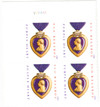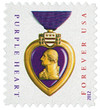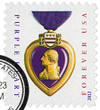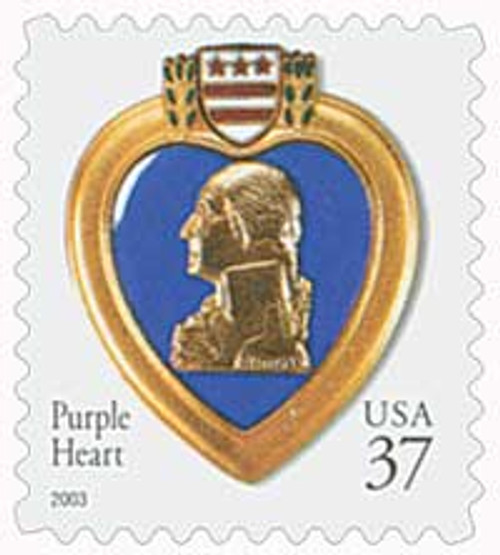
# 4704 - 2012 First-Class Forever Stamp - Purple Heart
U.S. #4704
2012 45¢ Purple Heart
The Purple Heart is one of the oldest military awards worldwide that is open to all who are wounded in battle. The Badge of Military Merit (the predecessor of the Purple Heart) was first awarded on August 7, 1782, by General George Washington. With the Revolutionary War nearly over, Washington wanted some way to repay his troops for their sacrifices. He created the Badge of Military Merit, to be awarded to soldiers displaying high merit and serving for over three years. Only three badges were known to have been awarded to Revolutionary War soldiers, with no documentation of any others until after World War I.
In October 1927, Army Chief of Staff General Charles Pelot Summerall petitioned Congress to have the badge revived, but the bill failed. Four years later, General Douglas MacArthur resumed Summerall’s work, overhauling the badge’s design and issuing it on the 200th anniversary of Washington’s birth. From 1932-43, the Purple Heart was awarded for wounds received in action and for acts of high merit.
In 1943, with the establishment of the Legion of Merit – a military decoration awarded for exceptional service and achievement – the requirements for the Purple Heart changed. Since then, a person must be a member of the U.S. Armed Forces and wounded or killed in action to be awarded the Purple Heart.
The 2012 Purple Heart stamp features a photograph taken by Ira Wexler of a Purple Heart Medal awarded during World War II. The image of the medal was enlarged from that used on the 2011 stamp.
Sinking Of The SS Dorchester
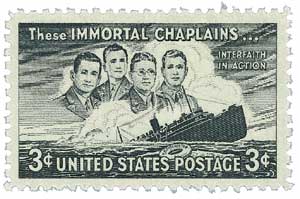
On February 3, 1943, after the SS Dorchester was sunk, the Four Chaplains sacrificed their lives to protect the other men on their boat.
The U.S. Army Transport Dorchester (formerly a coastal liner) left New York on January 23, 1943, with 904 passengers and crew aboard. Among them were four men who had met at Army Chaplains School at Harvard University – Methodist Minister George L. Fox, Protestant Minister Clark V. Poling, Catholic Priest John P. Washington, and Reform Rabbi Alexander D. Goode.
The Dorchester was one of three troop transport ships in a convoy. The crew was on high alert because German U-boats had attacked American ships in the same area near Newfoundland. Because of the concern of attack, the men were ordered to sleep in their clothes and wear their life jackets. But many ignored the command because they found it hot and uncomfortable. Shortly after midnight on February 3, the Dorchester was hit by a torpedo. The blast knocked out the electrical system, and left passengers trapped below deck in darkness.
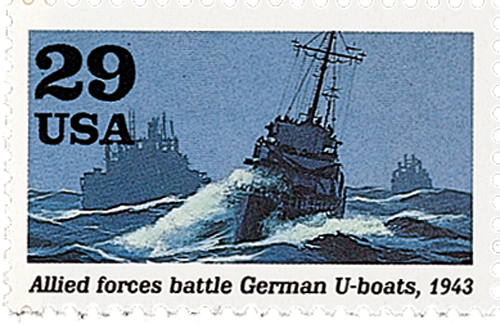
Chaos ensued, but the four Chaplains calmed those on board while organizing the evacuation. As they passed out life jackets, they found there weren’t enough for everyone, so the four Chaplains gave theirs away to other men on board. After helping as many of the men into lifeboats as they could, they linked arms, said prayers, and sang hymns until the ship eventually sank.
According to one survivor, “As I swam away from the ship, I looked back. The flares had lighted everything. The bow came up high and she slid under. The last thing I saw, the four Chaplains were up there praying for the safety of the men. They had done everything they could. I did not see them again. They themselves did not have a chance without their life jackets.” Of the 904 men initially aboard the ship, just 230 were rescued, as hypothermia took countless lives.
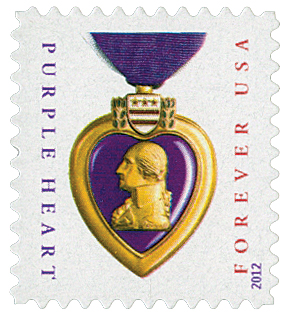
In December 1944, the four Chaplains were posthumously awarded the Distinguished Service Cross and Purple Heart. Members of Congress hoped to award the chaplains the Medal of Honor, but because they were not under fire at the time of their bravery, they didn’t qualify. Instead, Congress created the Four Chaplains’ Medal. In 1961, President Eisenhower presented the new medal to the Chaplains’ families. Congress further honored the Chaplains in 1988 by proclaiming February 3 as Four Chaplains Day.
In the years since the sinking, the Chaplains have been honored in a number of ways. These include several chapels and stained glass windows, sculptures and plaques around the country, as well as books and a documentary, which you can watch here. In 2002, survivors of the Dorchester and the German U-223 that attacked it, met in a reconciliatory meeting.
Value: 45¢ 1-ounce first-class letter rate
Issued: September 4, 2012
First Day City: Washington, D.C.
Type of Stamp: Definitive
Printed By: Avery Dennison
Printing Method: Photogravure
Perforations: Die Cut 11
Self-Adhesive
Quantity Printed: 300,000,000 stamps
The Purple Heart stamp was first issued in 2003 and was re-printed again each year between 2006 and 2009. In 2011, the stamp was redesigned to include the ribbon at the top.
U.S. #4704
2012 45¢ Purple Heart
The Purple Heart is one of the oldest military awards worldwide that is open to all who are wounded in battle. The Badge of Military Merit (the predecessor of the Purple Heart) was first awarded on August 7, 1782, by General George Washington. With the Revolutionary War nearly over, Washington wanted some way to repay his troops for their sacrifices. He created the Badge of Military Merit, to be awarded to soldiers displaying high merit and serving for over three years. Only three badges were known to have been awarded to Revolutionary War soldiers, with no documentation of any others until after World War I.
In October 1927, Army Chief of Staff General Charles Pelot Summerall petitioned Congress to have the badge revived, but the bill failed. Four years later, General Douglas MacArthur resumed Summerall’s work, overhauling the badge’s design and issuing it on the 200th anniversary of Washington’s birth. From 1932-43, the Purple Heart was awarded for wounds received in action and for acts of high merit.
In 1943, with the establishment of the Legion of Merit – a military decoration awarded for exceptional service and achievement – the requirements for the Purple Heart changed. Since then, a person must be a member of the U.S. Armed Forces and wounded or killed in action to be awarded the Purple Heart.
The 2012 Purple Heart stamp features a photograph taken by Ira Wexler of a Purple Heart Medal awarded during World War II. The image of the medal was enlarged from that used on the 2011 stamp.
Sinking Of The SS Dorchester

On February 3, 1943, after the SS Dorchester was sunk, the Four Chaplains sacrificed their lives to protect the other men on their boat.
The U.S. Army Transport Dorchester (formerly a coastal liner) left New York on January 23, 1943, with 904 passengers and crew aboard. Among them were four men who had met at Army Chaplains School at Harvard University – Methodist Minister George L. Fox, Protestant Minister Clark V. Poling, Catholic Priest John P. Washington, and Reform Rabbi Alexander D. Goode.
The Dorchester was one of three troop transport ships in a convoy. The crew was on high alert because German U-boats had attacked American ships in the same area near Newfoundland. Because of the concern of attack, the men were ordered to sleep in their clothes and wear their life jackets. But many ignored the command because they found it hot and uncomfortable. Shortly after midnight on February 3, the Dorchester was hit by a torpedo. The blast knocked out the electrical system, and left passengers trapped below deck in darkness.

Chaos ensued, but the four Chaplains calmed those on board while organizing the evacuation. As they passed out life jackets, they found there weren’t enough for everyone, so the four Chaplains gave theirs away to other men on board. After helping as many of the men into lifeboats as they could, they linked arms, said prayers, and sang hymns until the ship eventually sank.
According to one survivor, “As I swam away from the ship, I looked back. The flares had lighted everything. The bow came up high and she slid under. The last thing I saw, the four Chaplains were up there praying for the safety of the men. They had done everything they could. I did not see them again. They themselves did not have a chance without their life jackets.” Of the 904 men initially aboard the ship, just 230 were rescued, as hypothermia took countless lives.

In December 1944, the four Chaplains were posthumously awarded the Distinguished Service Cross and Purple Heart. Members of Congress hoped to award the chaplains the Medal of Honor, but because they were not under fire at the time of their bravery, they didn’t qualify. Instead, Congress created the Four Chaplains’ Medal. In 1961, President Eisenhower presented the new medal to the Chaplains’ families. Congress further honored the Chaplains in 1988 by proclaiming February 3 as Four Chaplains Day.
In the years since the sinking, the Chaplains have been honored in a number of ways. These include several chapels and stained glass windows, sculptures and plaques around the country, as well as books and a documentary, which you can watch here. In 2002, survivors of the Dorchester and the German U-223 that attacked it, met in a reconciliatory meeting.
Value: 45¢ 1-ounce first-class letter rate
Issued: September 4, 2012
First Day City: Washington, D.C.
Type of Stamp: Definitive
Printed By: Avery Dennison
Printing Method: Photogravure
Perforations: Die Cut 11
Self-Adhesive
Quantity Printed: 300,000,000 stamps
The Purple Heart stamp was first issued in 2003 and was re-printed again each year between 2006 and 2009. In 2011, the stamp was redesigned to include the ribbon at the top.






